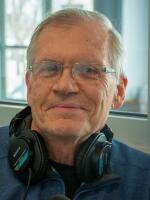Dr. Shannon Hoime was struck each day by the eerie quiet of New York City under the pall of the COVID-19 pandemic.
But she was inspired each night by the city’s communal racket.
“Every night at 7 p.m., cymbals and tambourines, a lot of noise,” Hoime said last Friday night during a telephone call from her New York City hotel room. “It was really cool.”
Most of what Hoime experienced during her almost three weeks in New York City wasn’t cool at all. It was a place of dread and life-and-death drama. And she was there as a volunteer — one of the tens of thousands from across the nation — to help the overburdened medical providers handle the deluge of patients struggling to survive COVID-19.
“We were set up in a field hospital in an indoor soccer stadium, a practice field,” Hoime said. “All our patients were COVID, but basically those that were recovering. They were the least sick of the COVID patients. We were trying to help take the load off of the hospitals.”
The Sioux Falls pediatrician and mother of three boys left family and friends and her Avera medical practice on Easter Day after being recruited by a former medical-school classmate who had a military career in emergency medicine.
Dr. Melissa “Missy” Givens, a retired Army colonel, worked with officials at New York Presbyterian-Columbia University Irving Medical Center to set up and staff the temporary hospital.
“She (Givens) had been deployed to the front lines in Iraq, so she had experience putting together a hospital in a tent, you know,” Hoime said. “And she ended up in New York, offering to help.”
Hoime ended up there, too, making the same offer to work in “The Bubble” at Columbia University’s Baker Field. It was converted from a practice facility to a field hospital in about a week and named the Ryan Larkin Field Hospital. Larkin was a decorated Navy SEAL who served multiple tours of duty in Iraq and Afghanistan and died in 2017.
COVID patients began arriving almost immediately at the field hospital after they had improved enough to be moved from regular hospital facilities.
“We took them once they were needing no more than 6 liters of oxygen (per minute),” Hoime said. “Most still needed oxygen, but only one that I can remember, out of about 100 who came in, was on a ventilator before coming to us. He was in his 40s, and I don’t think had any medical history. It can be very random.”
That was shown by the 90-year-old woman who spent only a few days at the field hospital before being discharged
“I think she was going home today,” Hoime said. “It can be pretty crazy, how different this disease can affect people.”
She and others felt “protected from the worst of it” working in The Bubble on patients who had either survived the worst stage of the disease or never reached it. But they were close enough to the worst of it to get a sense for what it was like in the emergency departments and intensive care units.
“I really feel for the ICU and ER doctors who had to deal with watching people die right in front of them and not being able to help,” Hoime said.
It was ironic that on the same day Hoime left Sioux Falls for New York City, Smithfield Foods announced that it would be temporarily closing its pork-processing plant in the city because of an outbreak of COVID-19 in the plant.
“I was wanting to do more, and it was pretty calm in South Dakota when I left,” Hoime said.
It would get less calm in the coming days as the total number of cases at Smithfield and in Sioux Falls rose sharply and the national-news spotlight centered on the plant, the city and the state.
Even so, nothing we have seen here has approached what they were facing in New York City. And Hoime was one of many who traveled to the city to help.
“It was inspiring to build up this new field hospital with those people and work real hard with them and feel like you were helping people,” Hoime said. “And then when you would get a chance to go out in the city, it was just kind of sad. It was so quiet. And you knew there was just a lot of fear, and a lot of grief, across the city.”
The fear in particular turned up in the hotel where Hoime was staying, where staffers didn’t want to clean her room because of her work with COVID patients. So Hoime did most of the cleaning and picking up things she needed for the room at the front desk.
“They were just scared, and you couldn’t blame them,” she said.
Her last night in the hotel room and in the city was on Friday, when we spoke by phone. She was scheduled for an early flight home to Sioux Falls Saturday morning, followed by some time off before returning to her regular practice.
The coming days off will be good both as a way to recover from the New York work experience and as a sort of self-quarantine, although that apparently won’t be needed. One of the last things she did in New York City was pass an important test: the one for the virus.
It was negative.


